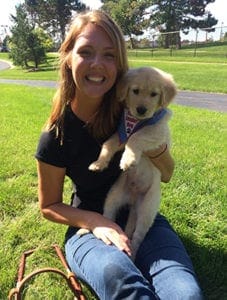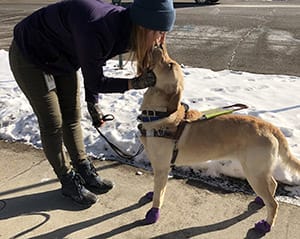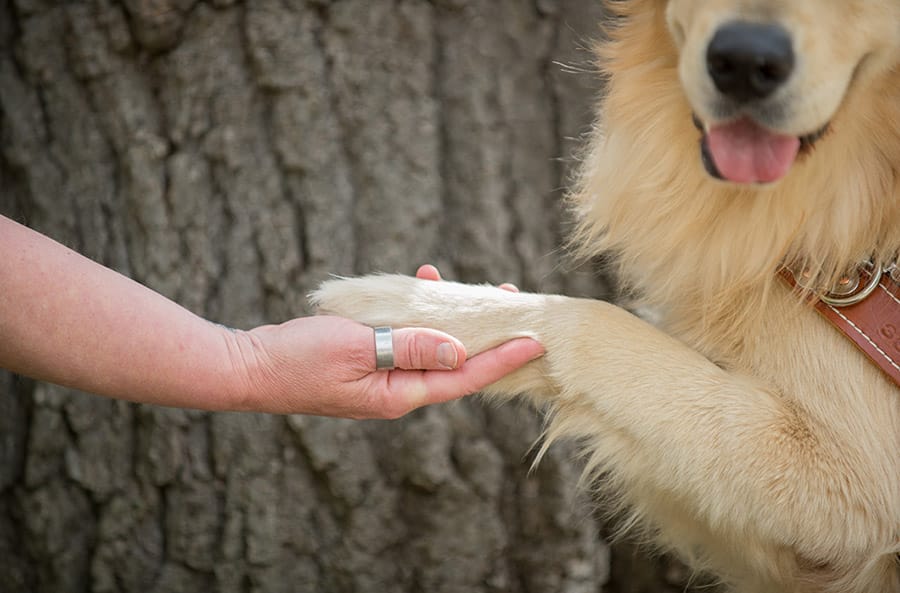By Guide Dog Mobility Instructor Ashley Nunnelly
I never wanted to be a guide dog instructor. Seriously! That was never on my radar for a career choice. I always loved animals growing up—dogs and horses especially—and was the child that had a strange encyclopedic-like knowledge about dog and horse breeds. If you name a dog breed, I can still give you average weight expectancy, temperament, AKC group, etc. (I was and still am a HUGE nerd). While I loved animals, my main love was the theatre. I was going to be an actress, then a director. Not Hollywood—I saw myself on Broadway. All of my free time from elementary school through high school was spent in rehearsals, voice lessons, building sets, working tech for shows and trying to make myself a less woefully terrible dancer then I am. The amount of show tunes that my poor parents listened to at a full belt in the shower must have caused them to have tap dance numbers all through their dreams. At one point I was fully convinced that I wanted to go to clown school. That’s about the time where my (very practical) dad’s hair started to go grey.
I went to the University of Georgia, and for roughly one semester I was on the pre-vet track. Then Chemistry 2 hit, I received a lead role as a freshman in a UGA Theatre Department play and my mind was made up. Broadway, here I come! So long, science and vet school! The next four years were spent in all theatre classes and rehearsals for department plays, after which I would go to rehearsals for student plays, working as the department’s prop master, the Commedia dell’Arte Troupe and STILL trying to become less of an abysmal dancer.
At the end of my freshman year, I started to see puppies around campus. Puppies in little yellow vests that said “Future Guide Dog” on the side. Those who know me now would be shocked at this, but I was too shy to even approach those girls and ask how to get involved. I thought it was so cool—some elite society that my nerdy self certainly wouldn’t be skilled enough to be a part of. My best friend and roommate, however, was quite different. She marched up to one of the girls and found out the website for where to apply!

It was December of 2010 when I brought home my first puppy to be raised for Guide Dog Foundation for the Blind (GDF). I was 19 years old. This was the first thing that I ever had to be responsible for on my own and I had NO CLUE what I was doing. Luckily, as all of us puppy raisers know, the puppy raising community for both GDF and Leader Dog is a fantastic place. I had ample support for all my questions and worries, I made friends (who are now lifelong friends) and had the sassiest of sassy collie puppies to basically raise me while I was raising her.
She quickly became a part of every aspect of my world, including my theatre world. She came with me to class and rehearsals, participated in contact improv sessions, hung out with friends with me—she even waited outside in the hallway while I was nervously auditioning for roles in the plays.
When she went in for training at GDF, I immediately brought home puppy number two. As every puppy raiser and client understands, suddenly your world isn’t quite your world unless you have a leash in your left hand and sweet eyes looking up at you. They’re there to be goofy and laugh with, they’re there to get you to play, they’re there to learn and soak up the world while they’re teaching you, and they’re there when you’re sad because maybe you didn’t get that role in the school play that you wanted.
Guide Dog Foundation is located on Long Island, NY and when I received word that puppy number one was graduating, I loaded up and drove 15 hours from Georgia to New York, New York. I made it to Broadway, just not in the way that I originally planned. I caught a show in the city on night one and the next morning I went to “Celebration Sunday” to meet my special girl’s special guy.
Funnily enough, her client is a man in his 50s who lived in Georgia! We sat and talked for hours, and that’s when he told me the words that changed my life.
“I thank you so much for what you’ve done, because she is going to take me everywhere.”

That was it. Now I knew: this was what I was missing. This was what I wanted to do for the rest of my life. If me loving a dog could give so much to another person—independence, confidence, freedom—how could I not want to meet more incredible dogs and amazing people? Plus, just the one dog took me all the way to Broadway. Imagine all the places she was going to take him, and all the places that every other dog could take those clients.
I made my way to Leader Dog in 2015, and then I found home. It’s funny, because it is a seriously long way from my original Georgia home and very, very cold!
Leader Dog took the chance on me—a theatre nerd who SERIOUSLY can’t dance—and taught me how to dance with dogs. I have footwork for turns, I have leash cues, I have a clicker that I use to have perfect timing for communication, and I teach my dance partner (the dog) how to be a partner who knows how to take the lead for someone else.

Right now, I’m in the middle of intense rehearsals. My dogs and I are rehearsing daily. We’re an ensemble working for a common goal. We have to learn each other’s strengths and styles and we have to know how to teach and help each other when we need it. We practice and practice and practice new skills, new scenes, every day working toward that ultimate goal. Then, after four months of practice, it’s show time! Class is here! Clients are here! It’s time for my leading ladies and gentlemen to meet their new partners. All the work that we have put in comes together in class, and the clients take the stage to do their own hard work while I step behind the scenes.
I love what I do. I go to Leader Dog every day to work for an organization that has the most special and exceptional cast members. I meet incredible Leader Dogs and I meet incredible Leader Dog clients. And when I get to watch those dogs take those clients everywhere, it is brighter than all the lights of Broadway.


